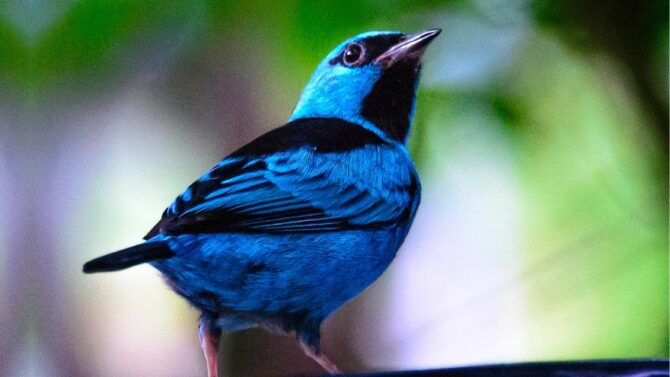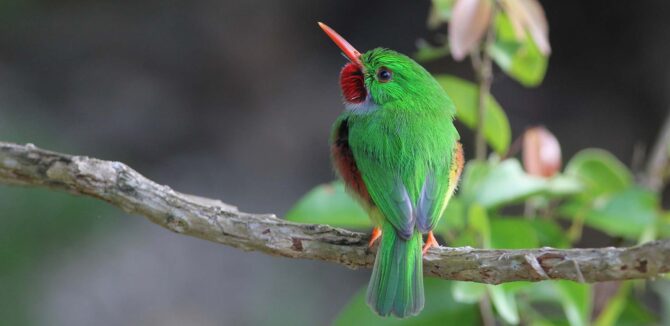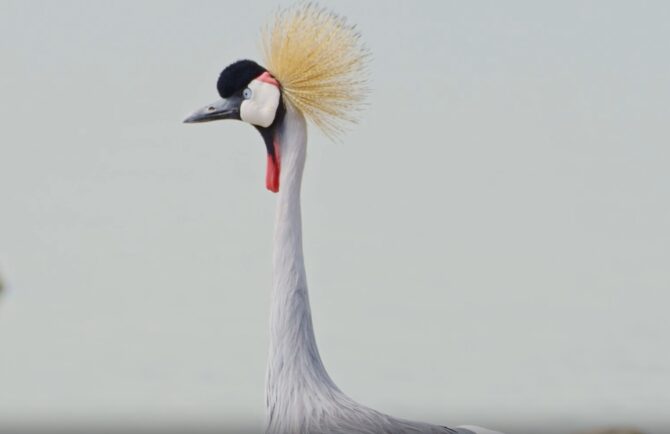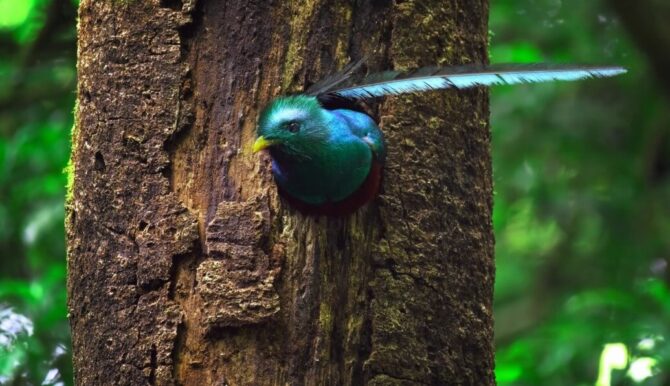The world’s avifauna is disparate and nothing short of a bird enthusiast’s Eden.
With 10,000 bird species that roam the earth, these feathery creatures range in size, feeding habits, and color of their feathers.
Birds that are blue are pretty birds with uniform blue color on their plumage, but no bird species create blue pigments.
Rather, the blue color covering their plumage is all visual and effectuated by how light waves relate to their feathers.
These different types of blue birds, called thrush, abound in their numbers, from the blue grosbeak, mountain bluebird, and indigo bunting to the blue jay, tree swallow, and Northern Parula.
We will now review the most beautiful blue birds in the world, considering their geographical range and identifying features and other interesting facts.
Different Types of Blue Birds
1. Mountain Bluebird
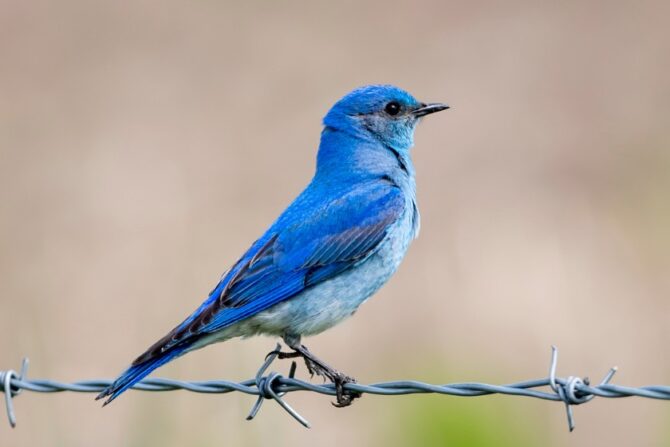
- Scientific name: Sialia currucoides
- Length: 6.1 inches to 7.1 inches
- Weight: 30 grams
- Wingspan: 11.0 inches to 14.2 inches
- Identifying features: Adult males are greenish-blue above and light blue underneath. The adult female has blue wings and tail, grey breasts, grey throat, back, and crown that are dull in color. Their song is a vocalized high ‘chur.’
- Where found: West Northern America and central Mexico
The male Mountain Bluebird parades with the color of the skyline. However, the underside of its tail and wings is a bit darker and blanched.
The females do not exude as many aesthetic colors as their male counterparts. Rather, they disport a gray-brown with pigments of pale Blue around the wings and tail.
At times, these birds display an orange-brown implant on the chest. The bills of the mountain bluebird are all black.
This beautiful bird is endemic to the west’s wide open spaces, especially in the middle and higher uplands. Its ability to drift distinguishes the mountain bluebird from other bluebird species.
2. Blue Jay
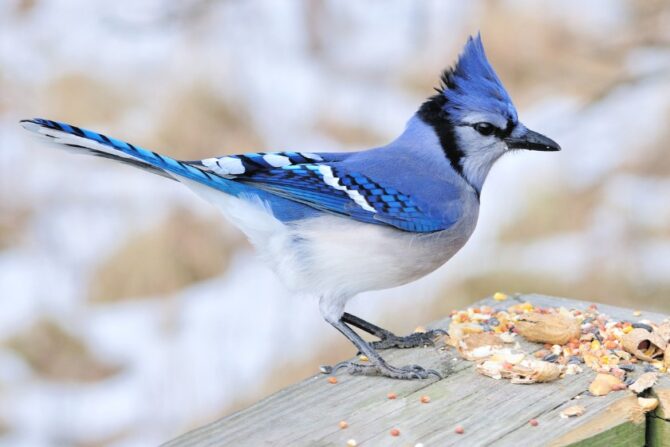
- Scientific name: Cyanocitta cristata
- Length: 9.8 inches to 11.8 inches
- Weight: 70 grams to 100 grams
- Wingspan: 13 inches to 17 inches
- Identifying features: Upper body has various shades of white, blue, and black, while its underbelly is white.
- Where found: North America
This species is a songbird with a wide rounded tail and a large crest. The wings and tail of the blue jay are banded with black, and its wing bar is white.
This little passerine is very aggressive, noisy, and bold. They make diverse kinds of calls that can be heard from far distances.
Flying quietly in open areas, especially during migration, they stuff food items in their throat pouch to store elsewhere.
Blue Jays are endemic to forest edges but can often be seen in cities, parks, and towns. Indigenous to eastern North America, it spawns in both coniferous and deciduous forests.
3. Tree Swallow
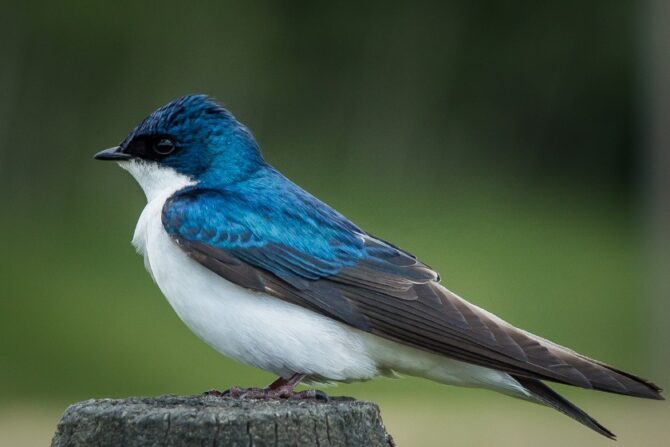
- Scientific name: Tachycineta bicolor
- Length: 4.7 inches to 5.5 inches
- Weight: 17 grams to 25.5 grams
- Wingspan: 12 inches to 14 inches
- Identifying features: Adult males mostly have glistening blue-green upperpart, blackish wings, and tails. The cheek patch and the underpart are white. Black bill, dark brown eyes, pale brown legs, and feet. Adult females are duller in appearance than males.
- Where found: North America
This beautiful aerialist bird is spectacular in the way it lives its life. Displaying brilliant-deep blue iridescent backs and spotless white fronts.
Having an average lifespan of 2.7 years and a maximum of 12 years, it is vulnerable to a wide range of predators.
Tree swallows are endemic to the U.S. and Canada. A migratory bird and an aerial insectivore foraging for food in groups or solitary.
This swallow is susceptible to parasites, but during the nestling, this has no or little effect.
4. Indigo Bunting
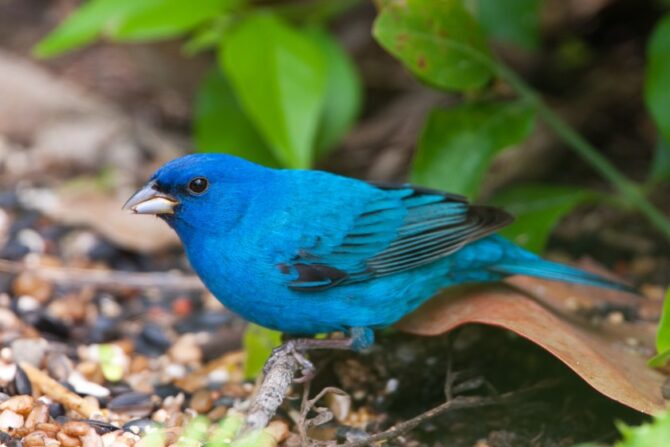
- Scientific name: Passerina cyanea
- Length: 4.5 inches to 5.1 inches
- Weight: 15 grams
- Wingspan: 7.1 inches to 9.1 inches
- Identifying features: Mature males plumage, entirely blue, a dazzling silvery bill. Female plumage is normally brown, white throat and a tint of Blue on its tail, rump, and wings.
- Where found: North America and northern South America
The blue indigo bunting resembles a scrap of the sky wings. Adult male shows off a flourishing cerulean blue mostly during the breeding season.
Only the head of the bunting is indigo, while its tails and wing are black with cerulean blue edges.
This aesthetic bird, like its others, lacks blue pigments. Instead, its exquisite color results from a microscopic structure in its feathers that reflects and refracts blue color light.
Mostly found in Northern America, the indigo bunting migrates at night. The bunting makes use of the stars as a compass.
5. Steller’s Jay
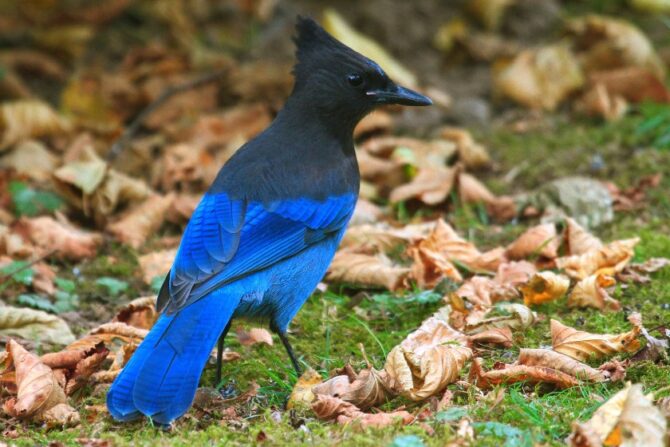
- Scientific name: Cyanocitta stelleri
- Length: 11.8 inches to 13.4 inches
- Weight: 100 grams to 140 grams
- Wingspan: 17.3 inches
- Identifying features: Has a slender bill and long legs. Black or dark blue head. Shoulders and lower breasts are sliver blue and have a triangular crest that stands almost straight.
- Where found: West of North America
Unique in its appearance, it looks like a bird with a helmet on its head. From a distance, this hefty songbird appears dark, lacking the white underbelly of most species.
This large songbird has rounded wings, chunky bodies, and a powerful straight bill. The steller’s jay is a very intelligent, curious, and bold bird.
Soaring with calm wingbeats, they explore the forest’s canopy and often come to the forest ground to look for food.
They are found in the forested area of west Northern America and as far as the east of the eastern foothills of the rocky mountains.
6. Blue Grosbeak
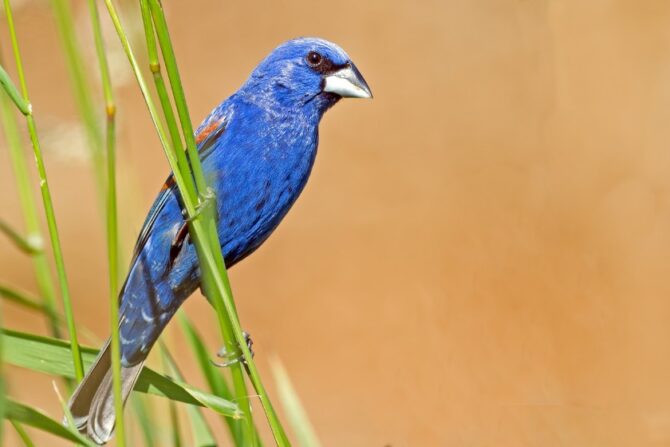
- Scientific name: Passerina caerulea
- Length: 5.5 inches to 7.5 inches
- Weight: 28 grams
- Wingspan: 10 inches to 11 inches
- Identifying features: The male is deep Blue, having black and brown on its wings. The female is mainly brown. Each sex is differentiated by its double wing bars and sizeable, deep bill.
- Where found: North America, Mexico, the Caribbean islands, and Puerto Rico
The Blue Grosbeak is a squatty songbird with a big triangular bill that seems to cap its face from top to bottom.
Adorned with attractive deep Blue and both black and brown on its wing, it is a gorgeous bird perfect for a garden.
This migratory bird is mostly found in the United state of America. It Feeds on insects but will often eat seeds, spiders, snails, and wild fruits. It breeds in a low tree or bushes or tangled vegetation.
7. Cerulean Warbler
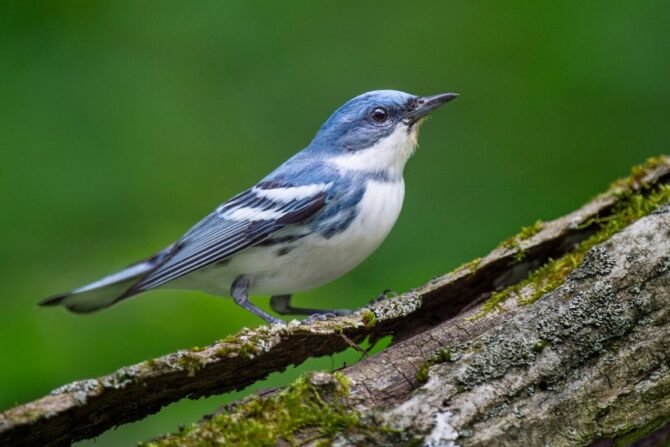
- Scientific name: Setophaga cerulea
- Length: 4.3 inches
- Weight: 8.6 grams
- Wingspan: 7.9 inches
- Identifying features: The adult male has a dark stripe on its back, a slim blue band around its neck, sky-blue upper parts, and blue streaks on each side of its white belly. The female plumage is yellow below and blue-green above.
- Where found: North and South America
- Conservation status: Vulnerable
This striking sky-blue wood warbler can appear turquoise in the correct light. The adult male is spotted with a deep, cerulean blue around its entire back and a white underbelly.
Like most warblers, females are different in appearance, with yellow feathers tinted with a blue wash.
The price of sighting a cerulean warbler merits a bit of pain in the neck. Rustling at the apex of the forest canopy, often 50 feet skywards.
The cerulean warbler feeds on insect larvae mostly. This long-distance migratory bird can be found in both North and South America.
However, this beautiful bird is currently rated near threatened, signifying that it is in danger of becoming vulnerable in years to come.
8. Blue-gray Gnatcatcher
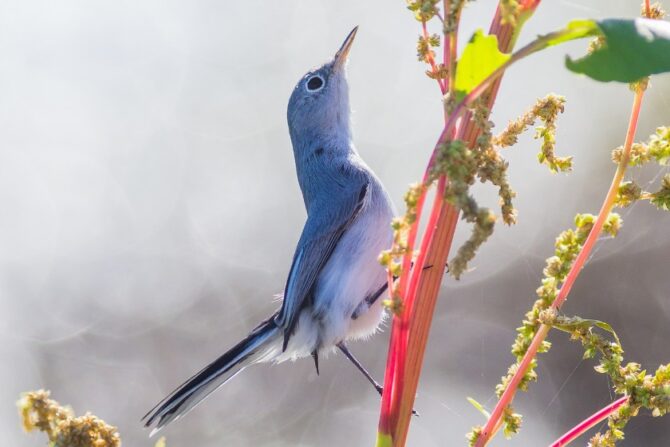
- Scientific name: Polioptila caerulea
- Length: 3.9 inches to 5.1 inches
- Weight: 6.5 grams
- Wingspan: 6.3 inches
- Identifying features: Blue-gray plumage, long tail, tiny and slim body with long legs, and a slender, straight bill.
- Where found: North America
The plumage above is pale blue-gray and grayish-white below. The blue-gray gnatcatcher may be small in size but very energetic.
Hardly slowing down, the gnatcatcher flickers after insects among trees and shrubs with its tail tilted at a steep angle.
This little songbird breeds in open deciduous forests and shrublands. Found mostly in the U.S. and Mexico, they migrate to the Bahamas, Cuba, and the Cayman Islands.
9. Barn Swallow
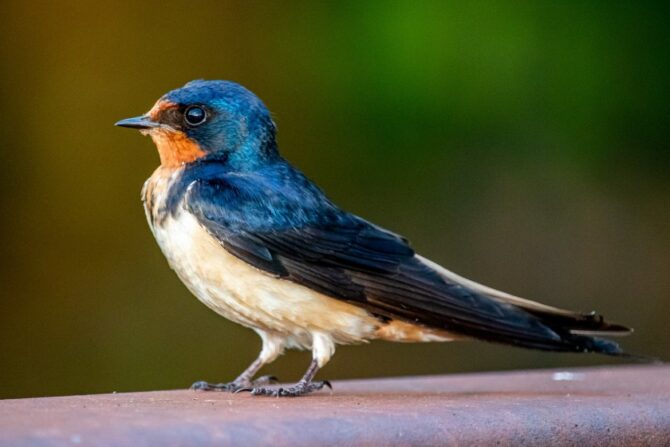
- Scientific name: Hirundo rustica
- Length: 5.9 inches to 7.5 inches
- Weight: 17 grams to 20 grams
- Wingspan: 11.4 inches to 12.6 inches
- Identifying features: Adult males have slivery blue wings, a tail and back, and golden underparts. The forehead and throat are reddish in color and elongated outer tail feathers. The female resembles the male, but the tail streamers are small.
- Where found: Asia, North and South America, Africa, and Europe
Barn swallows flaunt a deep purple-blue or navy blue on their head, wings, and back side.
An orange belly and face adorn this. It habits in an open country with low vegetation. Feeding on snagging insects above the ground or water of about 100 feet high.
They dart with steady wingbeats in a flash of straight flights and seldomly gliding.
The barn swallow is the largest naturally distributed passerine in the world. It is found in all the five habited continents of the world.
10. Eastern Bluebird
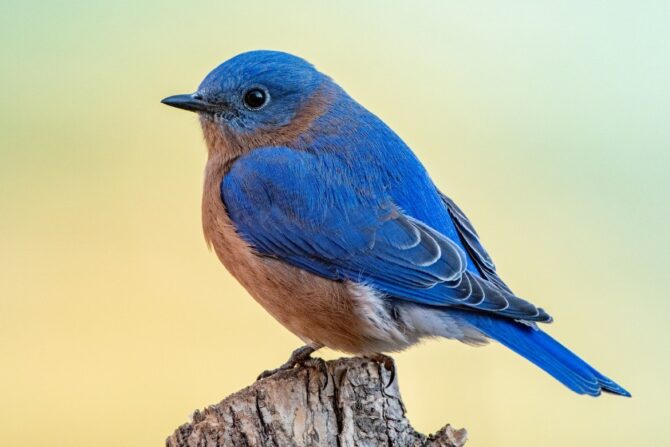
- Scientific name: Sialia sialis
- Length: 6.3 inches to 8.3 inches
- Weight: 28 grams to 32 grams
- Wingspan: 9.8 inches to 12.6 inches
- Identifying features: Male plumages are deep Blue above and reddish brown on the breast and throat. Female plumages are grayish above with an orange-brown breast.
- Where found: North America
The eastern bluebird is a passerine with a round belly, little legs, and long wings. Its bill is black, straight, and short.
It is a perching bird. What distinguishes a perching bluebird from other kinds of the bluebird is that they have a well-developed voice box.
This little passerine is an insectivore, dieting mostly on caterpillars, beetles, and crickets. However, it is preyed on by snakes, cats, and raccoons.
Skilled fliers with keen vision. They can see an insect on the ground from about 60 feet away.
Throughout the breeding phase, the male eastern bluebirds safeguard the female. They’ll take care and give extra attention anytime she leaves or arrives at the nest.
11. Lazuli Bunting
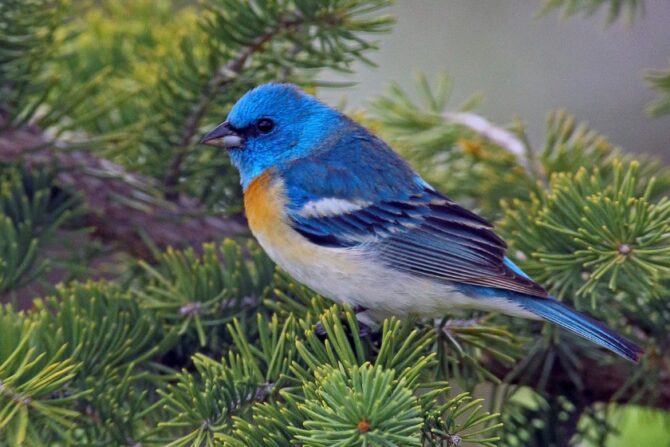
- Scientific name: Passerina amoena
- Length: 5.1 inches to 5.9 inches
- Weight: 13 grams to 18 grams
- Wingspan: 8.7 inches
- Identifying features: Adult males have a bright blue head and back, white wing bars and belly, and orange breasts. Females are brown with white wing bars and pale orange breasts.
- Where found: North America
The lazuli bunting males are small, brilliant Blue above with an orange-colored breast and a white belly. In contrast, females display grayish brown above, with a blue tint to their tails and wings.
However, female bunting is very difficult to distinguish from Indigo bunting. The pulchritude of this bird did not go unnoticed by the naturalist who titled it Passerina amoena, which means beautiful sparrow.
Feeding mostly on seeds and insects, the lazuli forages at various heights and hops between branches.
They occur in bushy areas, wooded valleys, and residential gardens. Native to the western part of the U.S., they migrate to Mexico.
12. California Scrub Jay
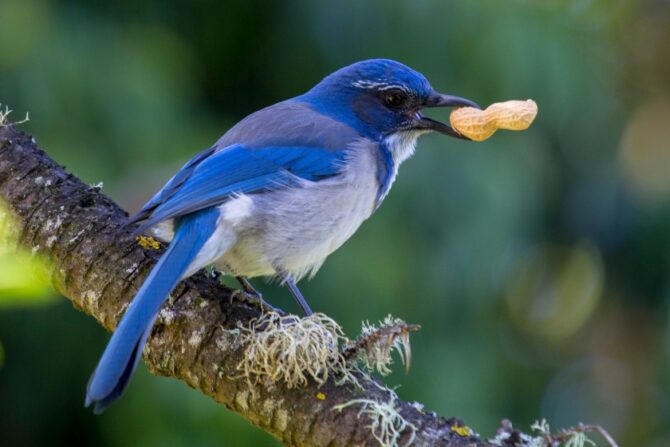
- Scientific name: Aphelocoma californica
- Length: 11 inches to 12 inches
- Weight: 89 grams
- Wingspan: 15 inches
- Identifying features: Eyebrows are white, with blue wings, head, and tail. A taupe back and silvery underparts
- Where found: California
A moderately large songbird with scrawny dimensions. Straight and stout bill with an arch at the tip. Azure blue and grayish underpart, this bird has a blue head, tail, and wings.
Dispoting a white throat that seems to have a blue necklace around it. Aggressive, curious, and vocal, the scrub jays outline themselves high in trees, on posts, and on wires where they act as outlooks.
The California scrub jay habit in open vegetation, pastures, woodland, and orchards. It feeds on insects, frogs, lizards, eggs, and the juveniles of other birds.
Like many other corvids, the California scrub jay is one of the most intelligent animals. The brilliant songbird is indigenous to western North America.
13. Siberian Blue Robin
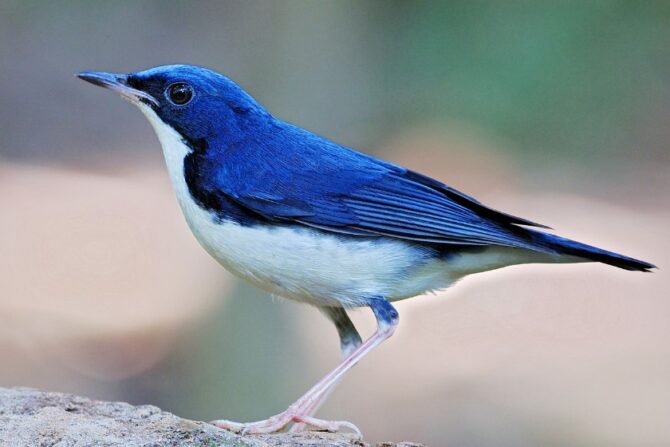
- Scientific name: Luscinia cyane
- Length: 5.3 inches to 5.7 inches
- Weight: 11 grams to 18 grams
- Wingspan: 7.8 inches
- Identifying features: Skinny, long-legged songbird males have dark blue upper parts and white under parts. Females have brown upperparts with blue-colored rump and whitish underparts.
- Where found: Siberia, Korea, Japan, and northern China
This flycatcher is a very shy bird. It has a routine of exposing itself only at the late hours of the day.
It is a radiantly colored songbird with luculent plumage differences between males and females.
Males display dark blue upper parts and white underparts, while females are predominantly brown on their upper parts.
Mostly feeding on insects and spiders, especially during the summer months. They occasionally snack on seeds, grains, and fruits.
The Siberian Blue Robin is an indigenous flycatcher to Asia. It reproduces in Japan, Russia, Korea, and Northern China islands.
In winter months, it is sighted in the southeastern countries of Asia. Siberian Blue is recognized as a vagrant in North America—this songbird inhabits areas with low, dense vegetation.
Related: 30 Types Of White Birds
14. Bluethroat
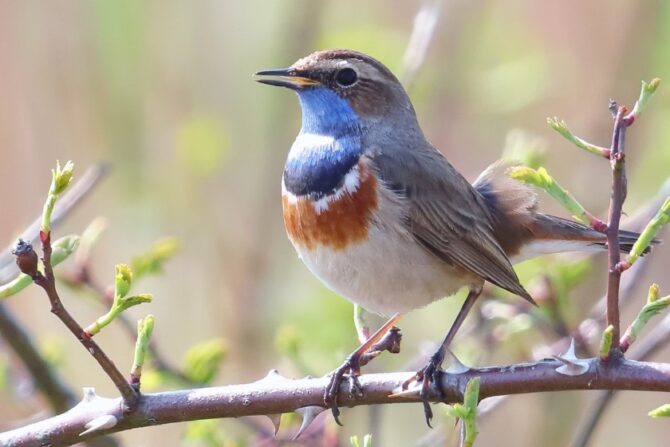
- Scientific name: Luscinia svecica
- Length: 5.5 inches
- Weight: 20 grams
- Wingspan: 8.6 inches
- Identifying features: Shrimpy, slender thrush, with a round belly. Illustrious blue throat margined below with bands of black, white, and reddish brown.
- Where found: Europe and west Alaska
The bluethroat is small, plain brown above, distinct black tail tinge with red side patches. It possesses a strong white supercilium.
The pigments on the male’s breast are said to have evoked the Swedish flag. This passerine, like its kind, is migratory and insectivorous.
Reproducing in the bushy swamp of Europe, the Palearctic, and western Alaska. The bluethroat is, however, very secretive and hard to sight as it skulks between dense vegetation.
It can only be seen when it is performing flight displays or singing. This old-world flycatcher is found in Europe, western Alaska, and north Africa.
15. Western Bluebird
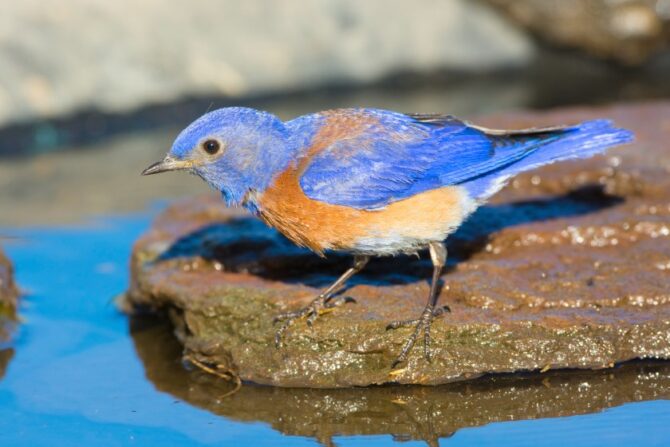
- Scientific name: Sialia mexicana
- Length: 5.9 inches to 7.5 inches
- Weight: 24 grams to 31 grams
- Wingspan: 11.4 inches to 13.4 inches
- Identifying features: Males are glistening blue above, with reddish-orange covering the breast and the upper back. Females are grayish with a dull orange wash on their breasts and a blue dye to the tail and wings.
- Where found: USA and Mexico
A bluebird with shiny blue plumage on its wings, tail, and head with reddish-orange extending from its breasts to its upper back.
However, the females appear gray-buff with a light orange wash on the breast and blue colors on their back and wings.
Native to the U.S., they range from the rocky mountains of California and Arizona down to Veracruz in Mexico.
The western Blue is very clubbable and outgoing, usually foraging in flocks during the non-mating season. They perch low to the ground in search of terrestrial insects.
This aesthetic thrush can be seen in both deciduous and coniferous woodland. However, this bird has lost its natural habitat through anthropogenic activities such as the felling of trees.
16. Northern Parula
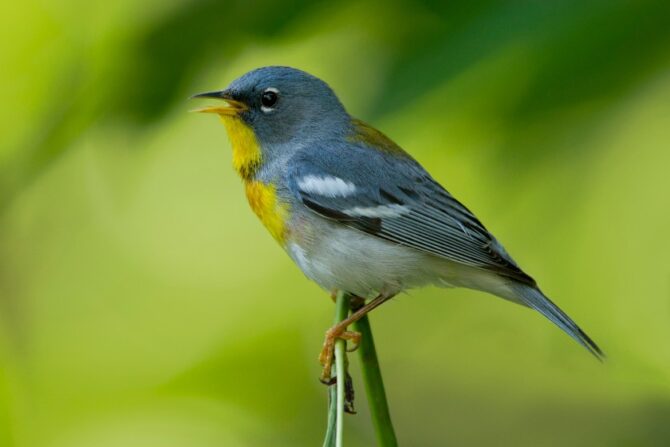
- Scientific name: Setophaga americana
- Length: 4.3 inches to 4.7 inches
- Weight: 5 gram to 11 gram
- Wingspan: 6.3 inches to 7.1 inches
- Identifying features: Pointed bill, bluish gray foremost part with a greenish back spot, and wing with two white bars. Yellowish breast dimming into the white tummy. Females look similar but often lack breast bands and are duller.
- Where found: North America
The Northern Parula is one of the many beautiful birds that are blue. Adult male plumage is bluish-gray with a blotch of yellow-green on the backside.
A chestnut collar parts the male’s lustrous yellow throat and chest. In contrast to the male, the female Parula are duller and do not display the male breast band.
What distinguishes the males from the females is their white eye crescent. Swiftly darting and hoping mostly through the loftiest level of the forest and understory.
Northern Parula is predominantly found in deciduous forests in the southern part of their cruise.
Black moss in the south and beard moss further north is the secret of their presence.
17. Bahama Swallow
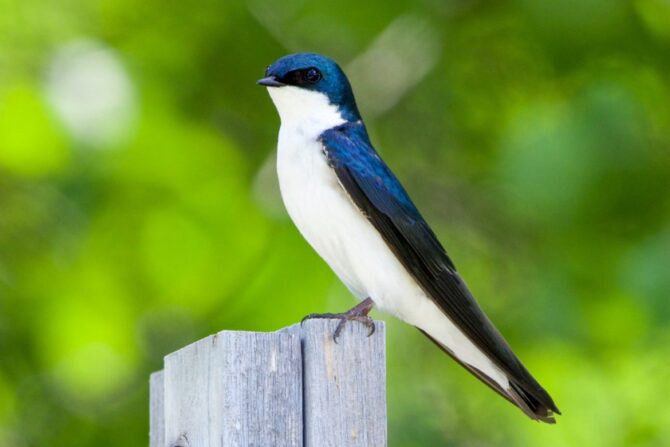
- Scientific name: Tachycineta cyaneoviridis
- Length: 5.5 inches to 6 inches
- Weight: 17 grams
- Identifying features: Two-toned, with blue and green upperparts and toneless underparts.
- Where found: The Bahamas
- Conservation status: Endangered
A graceful aerial hunter mostly sighted in the pine forest. Observe the well-streamlined body, greenish-blue upper parts, long diverged tail, and white underparts.
The tree swallow is of a similar color but has a shorter and indented tail. The swallow birds are not social.
They seldomly are in groups, or else they fly solo. It is an exotic bird found elsewhere during migration, including south Florida and Abaco.
However, it is also an irregular vagrant to South America. It is a bird of the Caribbean pine forests. Unfortunately, this swallow is a threatened species by logging and urban development.
It has been currently listed as Near Threatened as the population is declining gradually.
Endemic to the Bahamas and seen nowhere else in the world. Its continuity is completely in the hands of the Bahamian people.
18. Blue Mockingbird
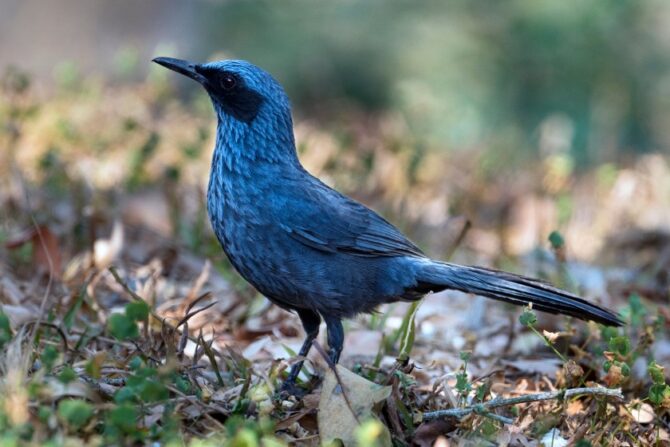
- Scientific name: Melanotis caerulescens
- Length: 9.5 inches to 10.5 inches
- Weight: 50.2 grams to 59.7 grams
- Wingspan: 14.5 inches
- Identifying features: A large thrasher with a long tail, uniformly blue plumage, with faint blue stripes on the breast, throat, and crown. Bill is slightly curved, with red eyes and gray legs.
- Where found: Mexico
Merely related to the northern mockingbird from a distance, this grayish-blue Mexican specialty is an evasive skulker of dense bushes.
The blue mockingbird’s head, back, tail, and wings are evenly blue. However, this blue color is determined by how the feathers are structured rather than pigments; hence, it can look grayish under shade.
This bird is an omnivore, predominantly feeding mostly on invertebrates and some vegetables.
One may find the mockingbird in dense thickets, humid forests, and pine-oak forests at elevations stretching from the lowlands to 8040 feet.
It is native to the mountains of Mexico but is vagrant to southern Arizona and Texas.
19. Varied Bunting
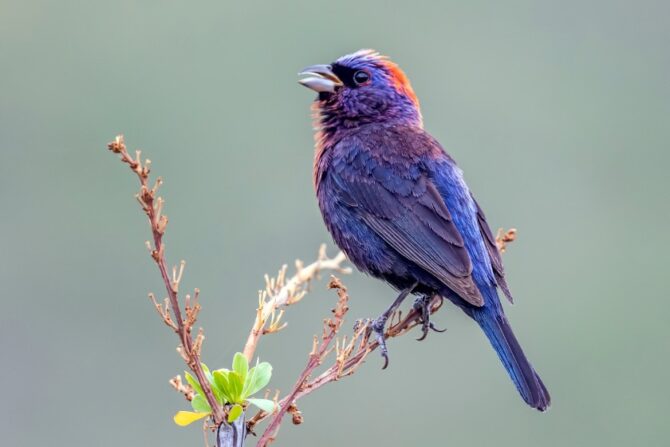
- Scientific name: Passerina versicolor
- Length: 4.3 inches to 5.5 inches
- Weight: 11 grams to 13 grams
- Wingspan: 8.3 inches
- Identifying features: Males have blue heads, greenbacks, and red underbelly. Females and juveniles have even illustrious yellow-green overalls with white eyering.
- Where found: Arizona, New Mexico, and Texas
A fine, dainty bluebird with a narrowly diverged tail and a brief, conical bill. Adult males display a mixture of purple and red.
They appear to be deep crimson above and below. In comparison, the female plumage is brown above and slivery buff below.
Its endowment of colors on its plumage makes it looks like a bird made for the circus. The varied bunting forages by flying through thickets, fiddling wings and tails, hawking for insects.
This exotic-looking bird also sometimes feeds on cacti, fruits, or seeds. Nesting in a thorny shrub, stream corridors, and surrounding areas.
The females brood for about fourteen days, laying two to five bluish-green eggs. The cruise of the varied bunting outstretches from the southern part of the U.S. throughout Mexico.
Related: Different Types of Purple Birds
20. White-Breasted Nuthatch
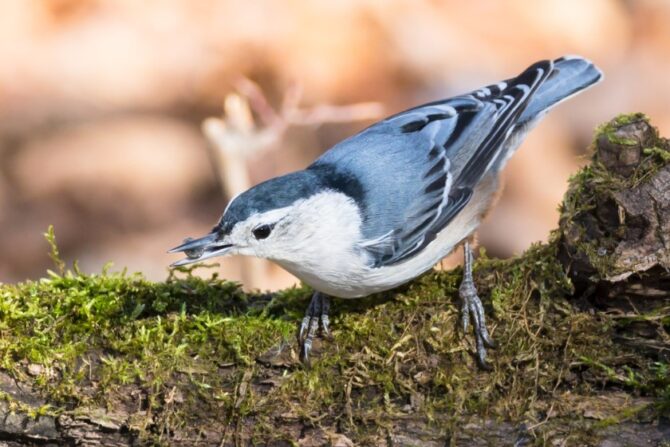
- Scientific name: Sitta carolinensis
- Length: 6.1 inches
- Weight: 18 grams to 30 grams
- Wingspan: 7.9 inches to 10.6 inches
- Identifying features: Gray-blue upper part, white face, and underparts. A long sharp pointed bill, compact tail with a gory tinge on the lower abdomen.
- Where found: North America
Ever seen or heard of a bird that wears a hoodie? Well then, meet the white-breasted nuthatch.
This passerine exhibit a dull blue upper part, a black collar on the upper part back, and a glistening black cap.
The black crown and its face frame make it appear like this songbird is wearing a hood. Its wings are deep gray with whitened fringes.
The face and underparts of this little bird are snow-white. However, it is an agile songbird, poking along trunks and outsized branches. Its habitats are in mature forests and woodland edges.
Interestingly, the white-breasted nuthatch is very boisterous and has a nasal voice that repeatedly utters little cries, often expressed with repetitions of a small unchanging whistle.
Feeding, during winter, its diet is mostly on seeds; in the summer, it feeds on insects. The white-breasted nuthatch is endemic and evenly distributed throughout northern America.
21. Purple Martin
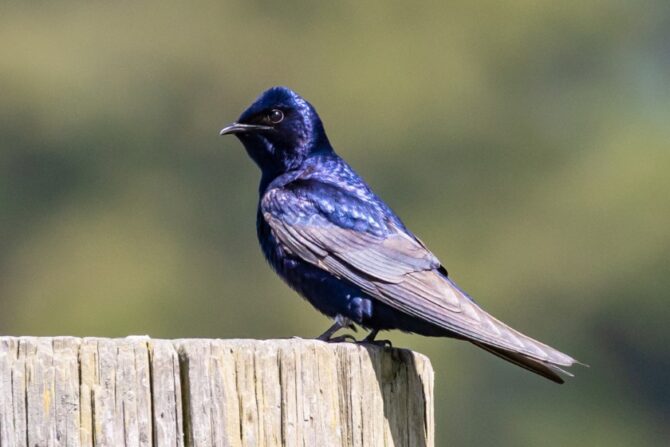
- Scientific name: Progne subis
- Length: 7.5 inches to 7.9 inches
- Weight: 45 grams to 60 grams
- Wingspan: 15.3 inches to 16.1 inches
- Identifying features: Adult males are polychromatic, with gloomy blue-purple plumage and black-brown wings and tails. Large, wide-chested bird. A narrowly hooked bill and a little forked tail. Females and juveniles are lusterless, with gray heads and chests with a chalky underpart.
- Where found: North and South America
Nicknamed ‘the dark swallows.’ The Purple Martins have a black, sheeny plumage that can be blackish-purple to bluish-purple.
These birds can even come out blackish-green occasionally. Immature Martins are tenderer, grayer, and display deferred plumage maturation.
It takes about a year for them to acquire their steel-blue shimmer. While males are dark all over, females have blotches of dark-colored feathers and brighter undersides.
Young males resemble females. The songbird of North America, the Purple Martin, is the most desirable neighborhood bird. It is the largest of all swallows and can perform phenomenal aerial acrobatics to seize a flying insect.
Interestingly, the Martin eats sand, small stones, broken glass, pieces of metal, egg shells, and other coarse material that assists it in decimating the hard bodies of the insects they feed on.
The adults also serve their newborns these objects, which provide the guts for digesting insects with a hard exoskeleton.
They breed in open areas, over eastern North America, and in some places along the west coast of British Columbia to Mexico.
22. Common House-Martin
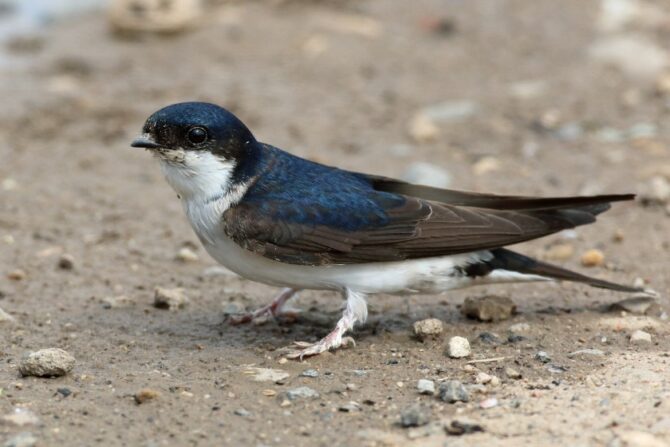
- Scientific name: Delichon urbicum
- Length: 5.1 inches
- Weight: 18.3 grams
- Wingspan: 10 inches to 11 inches
- Identifying features: Small in size, shiny blue-black upper parts, and all white underparts. A peculiar white rump and a forked tail when viewed closely. Legs and toes are covered with white featherings.
- Where found: Europe, Asia, and Africa
A spectacular small swallow with converted wings, white belly, rump, and the dorsal side looking steel-blue.
The legs are covered with white featherings, while parts of the leg that are featherless have a pink tinge.
They also possess brown eyes and a black bill. The common house martins paralleled to other swallows, are not equipped with a streamlined and perfectly forked tail.
This swallow reproduces socially and most often builds its nest with mud under the eaves of buildings.
However, this species has tremendously benefited from anthropogenic activities such as forest clearing, which establishes an open space that it prefers.
As an attractive bird that feeds on insects, the house martins have been accepted by humans when they built their nest on their builds.
It is also worth mentioning that the pileup of droppings of this species can lead to annoyance and, therefore, the demolition of certain nests.
Common house martin, solely called Martin, particularly in Europe, can be found in Africa, Europe, and Asia.
23. Cave Swallow
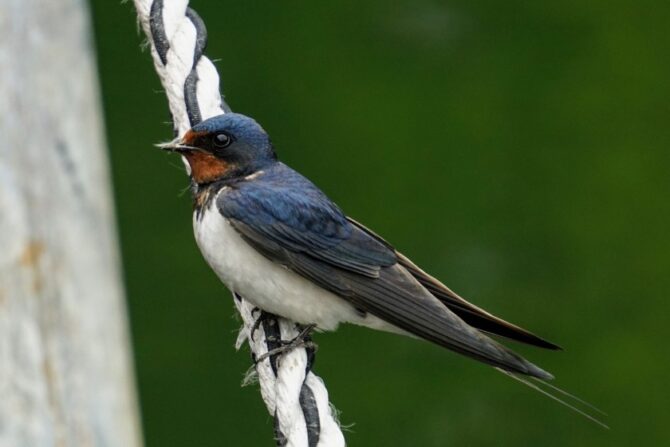
- Scientific name: Petrochelidon fulva
- Length: 5.5 inches
- Weight: 17 grams to 25 grams
- Wingspan: 13 inches
- Identifying features: A small, compact bird with a small head, short bill, and brownish wings. Plumages are gray-blue upper parts and reddish-brown forehead and throat.
- Where found: Bahamas, Cuba, Dominican Republic, Jamaica, Belize, El Salvador, Mexico, Panama, Canada, United States
The cave swallow is one of the most popular birds in the United States. Adorned with colorful plumage, black above and white below, with a reddish brown rump, forehead, and cheeks.
It is also characterized by a short bill, streamlined body, a compact, boxy tail, and very short legs. However, it resembles the common swallow.
This passerine was a rare bird, as in the 1960s, since it made it’s home only in caves.
But as of recently, this bird has learned how to nest in artificial sites, gutters, and under bridges and has become a very prevalent bird across much of southern New Mexico and Dallas.
This bird is an insectivore and prefers to forage in flocks against cliff faces and open vegetation.
Forages almost entirely in flight. This bird is fascinating because it drinks while in flight by gliding over the surface of pools and rivers.
24. Pinyon Jay
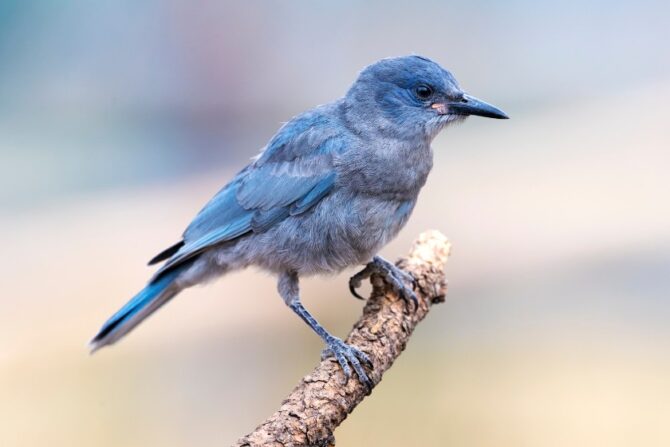
- Scientific name: Gymnorhinus cyanocephalus
- Length: 10.2 inches to 11.4 inches
- Weight: 99 grams to 120 grams
- Wingspan: 18.1 inches
- Identifying features: A small-sized and crestless bird with a short tail and pointed bill. Adult plumage is dull blue, with only the throat, breast, and chin sections striped whitish.
- Where found: Colorado, Oregon, New Mexico, Montana, California, and Nevada
- Conservation status: Vulnerable
The pinyon jay is true to its corvid nature, social and intelligent songbird. This jay has a superfine-looking blue body and a radiant cerulean face.
They fly in flocks, sending sparkles of blue around their Pinyon habitats. Pinyon pine seeds, grains, insects, lizards, and bird eggs constitute this jay’s diet.
However, they will primarily stick to feeding on the pinyon pine seeds. The availability of pinyon pine seeds influences the pinyon jay in where to pick a nest location.
Both males and females work hand in hand in nest-building; males are accountable for supplying nest materials, and females are responsible for erecting the nest. It forms a complex social family structure; a pair will naturally mate forever.
Pinyon Jays are endemic to central Oregon, central Montana, western South Dakota, central Idaho, and northwestern Nebraska, south to northern Baja, California, central Arizona, central New Mexico, and Oklahoma.
25. Cliff Swallow
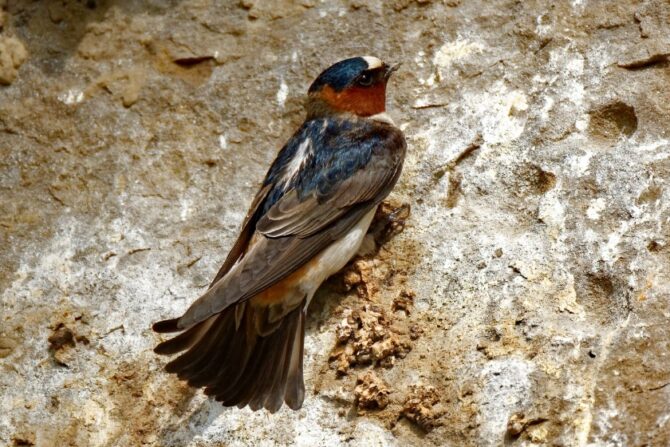
- Scientific name: Petrochelidon pyrrhonota
- Length: 5 inches to 6 inches
- Weight: 19 grams to 31 grams
- Wingspan: 11 inches to 13 inches
- Identifying features: In the dull light, they appear brownish with black throats and white underparts. In good light, they despot metallic, deep-blue backs and pale, deep orange rumps.
- Where found: North and South America
The cliff swallow is plausibly more prevalent today than when the Pilgrims arrived. This swallow has bulbous, broad-based wings, average length, paralleled tail, and a small head.
The plumages are brown with a dark throat and white underparts. They display metallic, deep-blue backs and pale, orange-colored rumps in the right light.
They have beautiful, brick-red faces and an illustrious buff-white forehead fixed up like a headlamp. Few juveniles despot whitish throats in summer and fall.
Primitively it constructs its jug-shaped mud nests on the sides of an escarpment. It takes advantage of urban settlements; the species has occupied many places it never nested.
These aerial insectivores communicate, using elongated vocal calls, as a warning or food availability. They are found in both North and South America.
26. Florida Scrub Jay
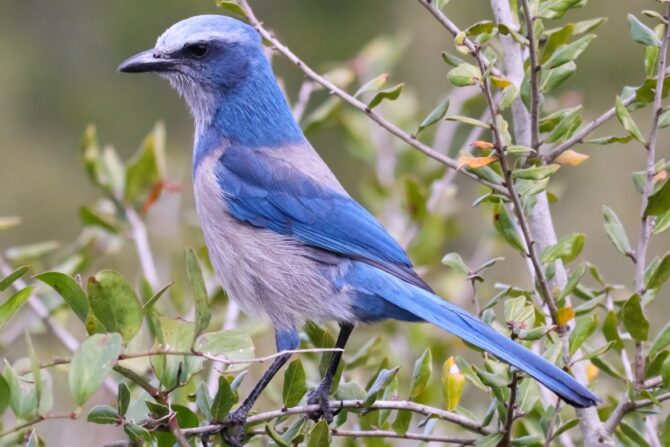
- Scientific name: Aphelocoma coerulescens
- Length: 9.1 inches to 11 inches
- Weight: 66 grams to 92 grams
- Wingspan: 13 inches to 14.2 inches
- Identifying features: A bird with bicolored plumage, blue wings, a tail, a head, and a whitish forehead. Unlike blue Jays, these species do not have a crest or black markings. The back and underparts are gray colored.
- Where found: Florida
- Conservation status: Vulnerable
A large and hefty songbird with a heavy bill. The scrub jay is a crestless bird with a big flat head and bulky legs.
This species is characterized by dull blue plumage with a whitish face and a blanched gray belly and back.
While this species can be tame, one may find them in the scrub with patches of open tree canopy and open beach feeding on peanuts.
Usually, it perches vertically on tree branches or exposed wires with its tail dangling. Amongst the species of scrub jay, the Florida scrub jay is one of the species indigenous to North America.
It’s the only species of bird native to the state of Florida and one of only 15 species indigenous to the continental United States.
The habitat of this curious species has been downsized in the past few decades as Florida perpetually develops. Unfortunately, this has led to a decline in the population of the Florida scrub jay.
27. Mangrove Swallow
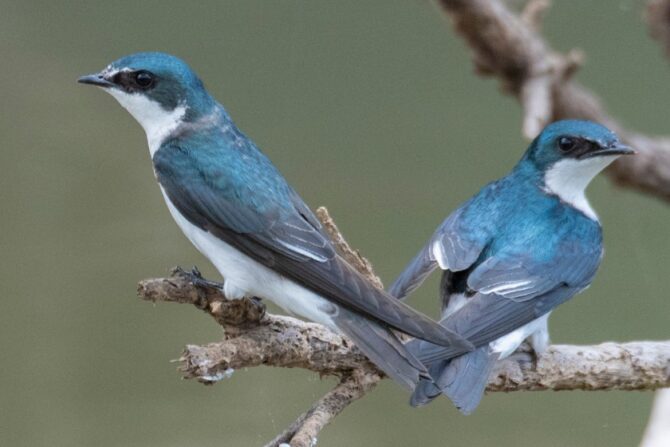
- Scientific name: Tachycineta albilinea
- Length: 4.3 inches to 4.7 inches
- Weight: 14 grams
- Wingspan: 11 inches to 13 inches
- Identifying features: Slightly forked tail with wide wings and iridescent green crown and back. White rump, underwing coverts, underparts, and eyes surrounded by white feathers.
- Where found: Mexico and all of Central America
The mangrove swallow is a terrestrial bird with an aerodynamic body built for hunting while in flight.
A passerine bird in the swallow family with a streamlined body, pointed wings, long eyes, and wide gaps.
It despots a blue-green upper part, dark flight feathers, a pale rump, a black tail, and white underparts.
The mangrove swallow preys on caterpillars, spiders, crickets, grasshoppers, and worms. It is a solitary bird, nesting about 160 feet away from each other.
The nests are built in artificial or natural grooves closer to water bodies, mostly in dead trees. They occur in open woodlands and grasslands.
This swallow is found throughout Mexico, Guatemala, Costa Rica, Belize, Honduras, and El Salvador.
28. Red-breasted Nuthatch
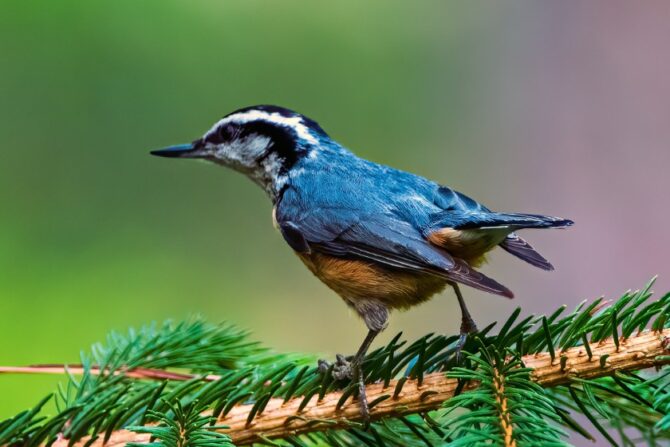
- Scientific name: Sitta canadensis
- Length: 4.3 inches
- Weight: 8 grams to 13 grams
- Wingspan: 7.1 inches to 7.9 inches
- Identifying features: Patterned head with a long bill and bluish-gray plumage. It has a black cap and white streaks over the eyes. The underbelly is smeared with a rusty-cinnamon color, paler in females.
- Where found: North America
Ever seen or met a bird that’s so small but packs a lot of energy and has a hobby of stealing nest-lining material from the nests of other birds?
The red-breasted nuthatch is a puny, bustling bird of the western mountains and northern woods.
This short-tailed, long-billed songbird navigates through tree canopies with other birds but stays closer to tree branches in search of insects.
The red-breasted nuthatch is often located by listening to their nasal, whining calls.
They could also be sighted on tree trunks such as spruce, fir, pine, and red cedars, to mention a few wandering up, down, and sideways above the bark.
Endowed with a bluish and rusty-colored plumage, a black cap, and a white supercilium. It is a native of the northern and subalpine forests, ranging from southern Alaska to the north of Mexico.
29. Painted Bunting
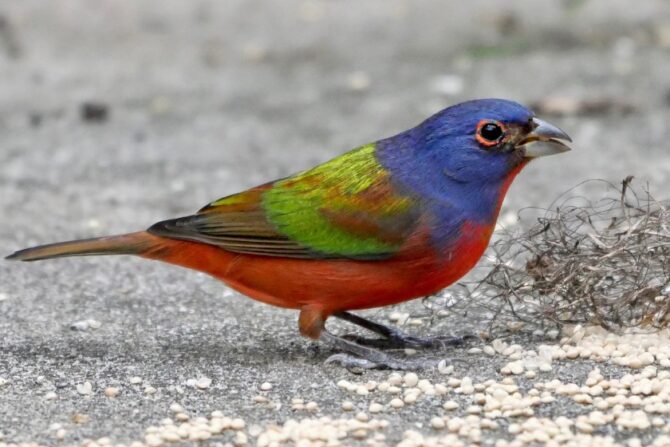
- Scientific name: Passerina ciris
- Length: 4.7 inches to 5.5 inches
- Weight: 13 grams to 19 grams
- Wingspan: 8.3 inches to 9.1 inches
- Identifying features: Males have blue heads, dark wings, greenbacks, red bellies, and rump. Females’ plumage is lime-green, lustrous above, and paler underparts.
- Where found: Arizona, Texas, New Mexico, South Carolina, Arkansas, Oklahoma, Cuba, and the Bahamas
- Conservation status: Near threatened
The aesthetic that’s the watchword for this songbird. A bird with all the rainbow colors, a sight pleasant to the eyes of anyone who beholds it.
No American songbird is as beautiful or eye-catching as the male-painted bunting.
Endowed with a blue head, yellow-green back, and red underparts, this exquisite bird turns heads whenever one shows up.
The painted bunting is a very secretive, shy bird that is difficult to study with the human eye. It prefers bushes, woodland edges, and riparian thickets as habitat.
Decades of continuous developments have declined the painted bunting population.
However, capturing and holding this species are considered illegal. Therefore, they occur in Mexico, the southeastern U.S., and Texas.
30. Ringed Kingfisher
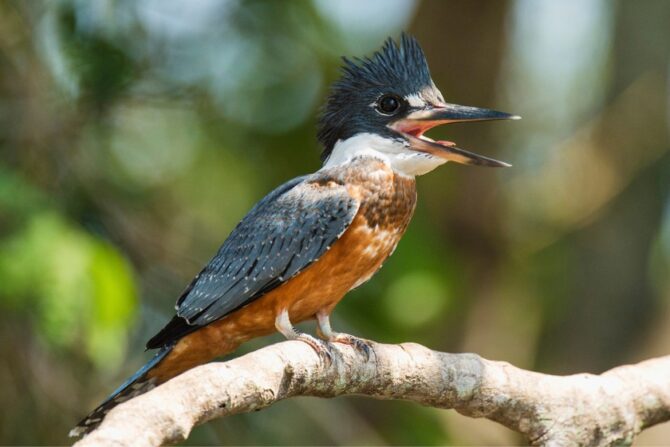
- Scientific name: Megaceryle torquata
- Length: 11 inches to 13.8 inches
- Weight: 140 grams to 170 grams
- Wingspan: 25 inches
- Identifying features: Has a huge bill, grayish-blue above with a reddish-brown color below. White-spotted wings and tail, and also with a white collar. Females are alike but have a wide bluish band on the breast and a pale crescent on the chestnut belly.
- Where found: Texas, USA, and South America
Undisputed, the ringed kingfisher is the largest in the Americas, with an excessively huge bill and raucous calls.
A blue-gray shaggy crest, white collar, and red belly characterize it. The male and female look alike but have different breast patterns: rufous on the male, whereas the female has a blue-gray band outlined by white.
Often seen browsing shallow waters for fish. This lovely bird with mohawk inhabits tropical and temperate marine shorelines, freshwater, and islands.
However, their nests are far away from the waters. They can be found in Costa Rica, Belize, Texas, Honduras, Guatemala, Dominica, Trinidad, and Tobago.
Frequently Asked Questions
How do I attract bluebirds?
You can attract bluebirds by installing a bluebird nesting box in your garden. Install the nesting box in an exposed area, five to six feet above the ground, and supply food such as mealworms or seeds and water in a bird bath.
Wrap Up
The American continent is a hub for various types of blue birds. These little passerines play a crucial role in the ecosystem, from seed dispersal to insect population control.
However, our feathery friends migrate or explore the horizons in search of food and breeding space.
Fortunately, most of these species of birds that are blue are far from being endangered.
Certain measures should be implemented to ensure their continuity, as human activities and environmental degradation could harm their population.
